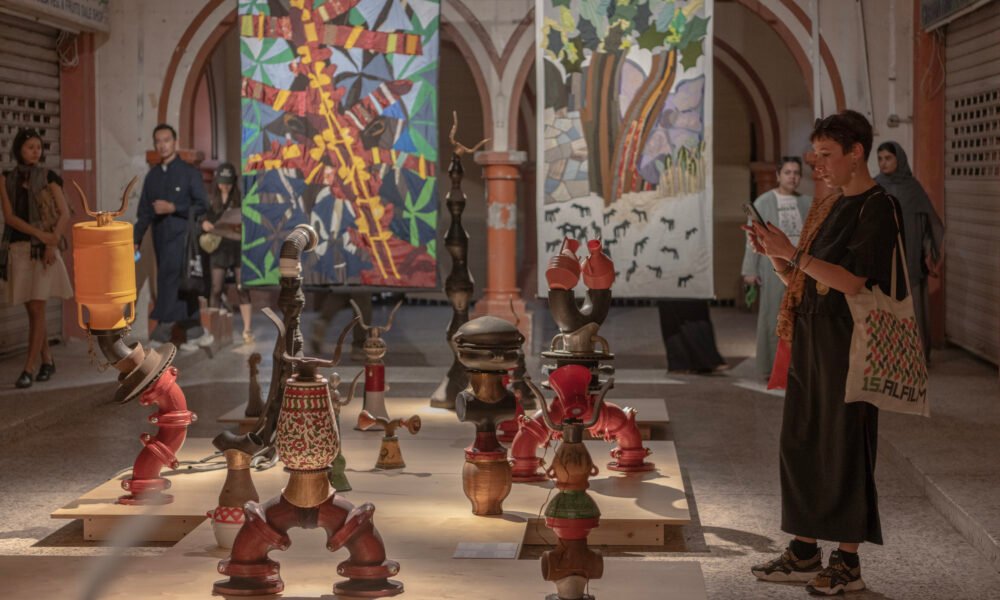
In Sharjah, 200 Artists Confront Global Issues Through a Regional Lens

The Sharjah Biennial, whose 16th edition kicked off in the UAE on February 6—and remains free to the public until June 15—unfurls across the territory with more than 650 works by a truly international array of artists. Launched in 1993, the Biennial has been overseen by Emirati curator (and daughter of the Sheikh) Hoor Al-Qasimi since 2003; she also founded the Sharjah Art Foundation fifteen years ago, instating a year-round local art infrastructure beyond the biennial.
The five curators selected to mastermind this edition are Alia Swastika, Amal Khalaf, Natasha Ginwala, Zeynep Öz and Megan Tamati-Quennell—the latter joked during an opening speech that they were like the Spice Girls, she being Scary—and they encouraged the audience “to both learn and unlearn.” The curators conceived of their projects both collectively (as “braided visions” per Natasha Ginwala) and individually, spotlighting narratives from diverse global perspectives and geographies, actively tackling fraught issues of structural oppression and diaspora.
This year’s Biennial theme, “to carry,” asks: what do we carry with us as we move around in the world—or, under dire circumstances, when we’re forced to leave behind what we know? The artists’ works provide responses to this query, however elliptically.
Centrally located, Al Mureijah Art Square encompasses six galleries. In one, Peruvian artist Claudia Martínez Garay’s whimsical spin on Andean heritage is expressed through tufted tapestries: in one, pre-Columbian artifacts humorously mingle with more banal items, like a roll of toilet paper and peppers, all affixed to a llama (but floatingly so). Across the gallery, British artist Olivia Plender’s board game is based on the first kind to ever be commercially manufactured: the royal game of the goose. Addressing capitalist systems, exploitation and colonialism, a sample card a player might draw instructs: “Steal the entirety of Gold belonging to the other players and Set Sail for The Levant leaving your own Debts unpaid.”


In another gallery, Lorna Simpson’s beguiling ongoing Earth & Sky series, featuring découpaged Black women from the magazines Ebony and Jet pasted with gems and crystals extracted from mineralogical encyclopedias, is juxtaposed near Indigenous Australian Daniel Boyd’s dotted paintings that reimagine his personal archives in oil, charcoal and archival glue on linen (here, a portrait of his grandmother, and a photo of his mother holding him as a child). In the next room, an astonishing fire engine-red Steinway concert grand piano—christened He Kōrero Pūrākau mo Te Awanui o Te Motu: Story of a New Zealand river, 2011—is gorgeously carved with Māori folk art tropes in a design by Indigenous artist Michael Parekōwhai, who represented New Zealand at the 54th Venice Biennale in 2011. The playing of the instrument is considered the completion of the work, and a pianist and dancer are occasionally present to animate the incredible musical object.
Adjacent to these, at Bait Habib Al Yousef, one can encounter in a cool dark room beneath wooden beams the elegant sculptural well by Risham Syed, beside which is propped a poem about earthly growth. Nearby are bright oil on linen paintings (curator Natasha Ginwala likens them as “Fauvist”) by Cassi Namoda, inspired by matrilineal scenes from her native Mozambique, as well as Kenya and South Africa, of women in the fields or tending to their children. Neighboring these are black-and-white photos of street life and photo studio signage snapped with a Rolleiflex by British-Nigerian photographer Akinbode Akinbiyi in Bamako.


The most poetic—meditative, but not precious—installation, arguably, is by Jorge González Santos: Jatibonicu (People of the Sacred High Waters), 2024-25, is an enchanting ensemble of draped cotton lace, burning wood and slender hand-made beef tallow candles. Drawing from the Indigenous Taíno peoples of the Puerto Rican archipelago, he privileges hearth and ceremony. The artist vocally encouraged visitors to light their own candles—which are dipped and dried in real time, then tied and gathered in bundles like bouquets. Igniting the flame and watching the wax melt into sinuous drippings is a prayerful gesture and an active way to partake in the fragrant setting.
At Bait Al Serkal Art Square, a 19th-century three-story building that formerly served as the earliest hospital in Sharjah, Sri Lankan-born Canada-based Rajni Perera’s works feature hybrid figures inspired by South Asian mythology’s “bad girls” and “revenge” schemes. In one piece, a cheetah straddles a large gray bird with a human head in its beak, as green parakeets fly nonchalantly about. Further into the labyrinthine venue, Tara Al Dughaither’s interest in women’s folk songs inspired her to organize and archive female vocal productions within the Gulf. Her installation acts as a casual catalogue of female singers via stacks of vintage cassette tapes; next door, her video from 2025 explores the movements of Iraqi dance. Salima Hakim from Jakarta presents Her Cabinet of Curiosities, a mixed media installation that champions the presence of women in archaeological research. Wedding scientific analysis and textiles, she fashions soft objects displayed in wooden boxes and embroiders abstracts of text from case studies onto long swathes of fabric (“Women, The Smaller Brain and the Bachelorette”).


Across the street, at the Sharjah Art Museum, the ground floor is wholly occupied by Biennial artists. In the recesses of the East Wing is a 50-meter blue painting by Sarah Abu Abdallah—You Ask, We Answer, 2025—peppered with amusing collage fragments (cats, sunsets, skeletons, squeeze bottles of stain and odor eliminator) intended to evoke her life in Saudi Arabia. In the West Wing, there’s an affecting image archive from Gaza, from the Photo Kegham studio founded in 1944. The founder’s grandson gathered vintage portraits and wedding snapshots, beach outings and parties, creating a meaningful memory bank of a people and place. There are excerpts of reactions to this archive; one person wrote, of seeing Kegham’s photos, that “they allow people like me, to finally feel rooted. A Palestinian of the diaspora, a refugee through and through—for once I was able to feel at home through those photos. To see where my mom and dad and grandparents walked, danced and swam.”
Miles away from any museum setting is a striking site in the far-flung Al Madam Buried Village, where American artist Hugh Hayden’s Brier Patch, 2022, emerges like a powerful vision. A conglomeration of aligned desks is nestled in the middle of the desert, each sprouting branches of salvaged cedar wood. It’s as if a magical spell had been cast to summon their growth, or a mirage appeared. Logistically, the visitor stands where the teacher would theoretically preside before the desks, but the sense of wonder is firmly childlike. The installation will gradually transform within the stark environs, changing color under the harsh sun and being slowly overtaken by sand as winds blow. Hayden’s site-specific work has previously been implanted in a forest in St. Louis and in New York’s Madison Square Park.


Similarly alfresco is Quandamooka artist Megan Cope’s outdoor sculpture Kinyingarra Guwinyanba (2024), embedded in Buhais Geological Park (a first-time site in the Biennial). Of the 102 wooden poles set against mountains and power lines, “It’s as if they’ve always been here, even though they were just planted,” Cope said. The poles are bedecked by repurposed oyster shells, which reference the diminishment of aquaculture in the artist’s native land—echoed by the local environmental legacy in the park itself, formed as far back as 93 million years ago and still containing today fossils from when the area was still a shallow sea.
Back indoors, at Al Hamriyah Studios, the vestibule dangles with Indigenous Australian artist Yhonnie Scarce’s delicate and glittering glass installation. Though aesthetically stunning, the work—consisting of hundreds of suspended hand-blown glass yams—belies the toxicity that inspired it and materializes a violent reality, namely the radioactive rain clouds caused by the nuclear testing conducted by the British in Australia in the 1950s and 1960s. In the first room off the vestibule, Rita Mawuena Benissan explores Ghana’s cultural history with two oversized royal umbrellas—one onto which a film is projected—surrounded by expressive portraits of Black figures. Several suspended works by Malaysia-born Indonesia-based artist Nadiah Bamadhaj are hung before huge alcoved windows. Using goat hide, buffalo hide, hand-blown glass and resin, these were inspired by motherhood and menopause.
At the Old Al Jubail Vegetable Market—full of archways, pockmarked walls, high windows, emptied stalls and abandoned signs for the likes of “Al Jazzat Juices” and “Al Majaz Dates Sale”—is, on one end, a large wood and steel mesh piece by the Palestinian artist collective Sakiya meant to recreate a version of the U.S. Capitol Building as a chicken coop. Given the way the American government is shaping up, it unsettlingly feels more literal than metaphorical. On the other end of the Vegetable Market, artist Ellen Pau’s A.I. projections on rounded screens, suspended over a pit of sand, feature the desert rose–an evolution from her previous fixation on the Bauhinia orchid tree, a symbol of resistance in her native Hong Kong.
In another repurposed location, the two-level Al Qasimiyah School (which still has murals of a yellow school bus and cute animals) is overhung in the central courtyard with billowing fabrics—recycled cotton bedsheets and pillowcases, plastic table runners, burial cloth, chiffon and silk—by Emirati artist Hashel Al Lamki. The space, built in 1971, was redone in 2019 for the Sharjah Architecture Triennial. The classrooms have been converted into spaces for watching films, like those by American artist Suzanne Lacy—The Crystal Quilt (about aging women) and In Mourning and in Rage (about biased media coverage of murdered women in L.A.)—and dance videos centering on the avant-garde practice of Indian choreographer Chandralekha.


In yet another repurposed location, the Kalba Ice Factory—a former industrial storage facility with high ceilings—is garlanded in horizontally hung ropes (vaguely reminiscent of pool lane dividers) sourced from Sharjah, connected by glass rungs that look “like stretched toffee.” The site-specific installation was dreamed up by New Zealand artist Kate Newby: she worked with volunteers from the maritime museum to set it up (the artist herself has a ship and anchor tattooed on her forearm). As the shadows change throughout the day, the work is “continuously in motion” like a sundial. Inside the Ice Factory hang richly hued oil paintings of the Navajo Nation reservation by First Nations artist Steven Yazzie, paired with another installation by Yhonnie Scarce, behind which screens the two-channel film installation Like a Flood, 2025, by artist Adelita Husni-Bey about Libya’s disrupted
The biennial excels at giving voice to artists who are not always included elsewhere in the world, providing access to underrepresented narratives, and this visibility widens the understanding of experiences across vast territories. Moreover, it’s interesting to see the way artists endeavor to engage in discourses surrounding towering issues, making viewers explicitly face unrelenting and problematic social and environmental realities. Throughout the Biennial, the works are described using overwrought, often politicized language, and the grandiloquent framing can, cumulatively, have a flattening effect. The curatorial decision to repeatedly use broad expressions like “speculative cosmologies,” “radical futurity,” and “collective wayfinding” aren’t always convincing or effectual, however ambitious the work attempts to be.
It’s also conspicuous that any mention of sexuality or other religions is in absentia—unsurprisingly, given that there’s an official state religion in the UAE, where an Ikea ad reads “every reason to be together this Ramadan.” Curators clearly know not to pick those types of projects for this context, but that doesn’t prevent them from remaining topical even if they’re not cited. The omission does not go unnoticed.
The biennial engages with Big Ideas, and making such art within the framework of the precarity and uncertainty plaguing our contemporary world is, of course, rewarding. As curator Megan Tamati-Quennell relatably declared, “art keeps me sane.”







No Comment! Be the first one.